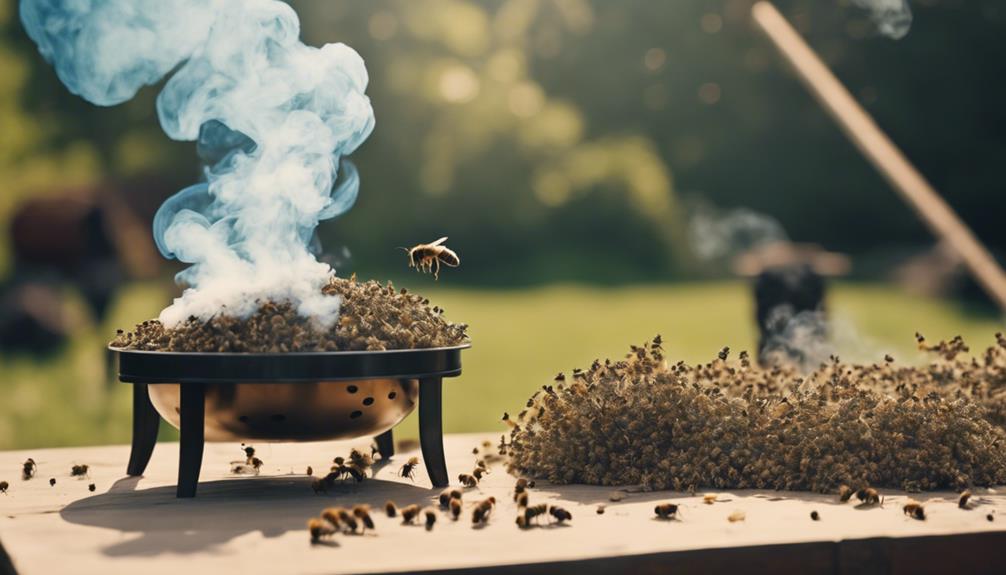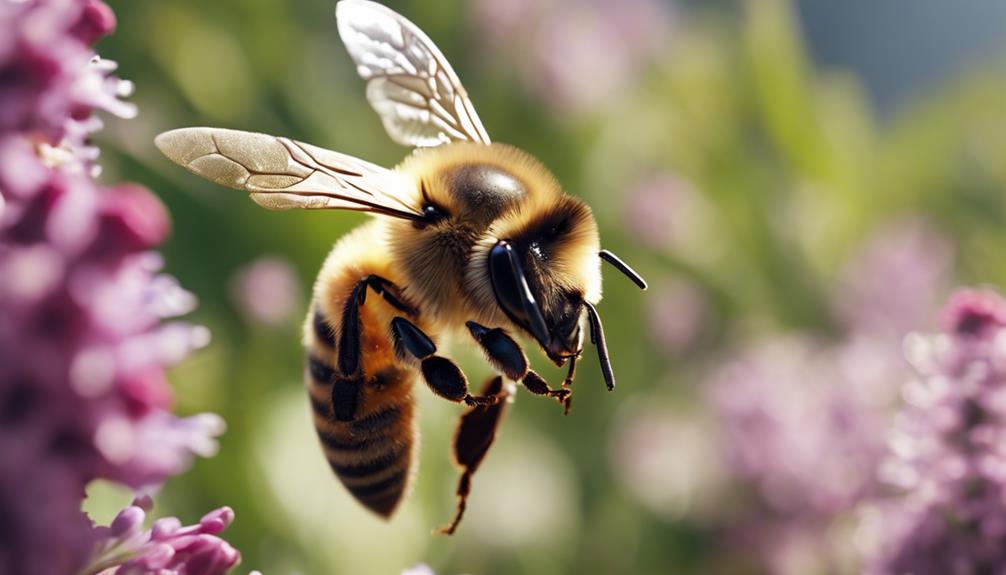When handling bees sans a smoker, we turn to clever alternatives to keep them calm and hive inspections stress-free. Think sugar syrup sprays, liquid smoke tricks, and gentle hive intrusion techniques as our secret tools for a smooth beekeeping ride. By mastering these bee-whispering techniques, we create a peaceful harmony that benefits both the bees and us beekeepers. If you want to uncover the secrets to a smoke-free beekeeping paradise, keep exploring for a buzz-worthy journey packed with tips and tricks for gentle bee interactions.
Main Points
- Use liquid smoke as an alternative to traditional smoking methods for calming bees.
- Implement sugar syrup sprays or water with peppermint extract to calm bees.
- Approach hives quietly and gently to avoid the need for smoke.
- Wear light-colored clothing and move smoothly to reduce bee agitation.
- Master gentle handling techniques to maintain hive harmony without smoking bees.
Alternative Beekeeping Methods
When beekeepers seek alternative methods for calming bees, they often turn to solutions like sugar syrup sprays or water with peppermint extract. These options offer a gentle way to calm our buzzing friends without the use of smoke.
While sugar water can be effective, it mightn’t reach all bees in the hive as thoroughly as smoke would. Some beekeepers also experiment with liquid smoke as an alternative to traditional smoking methods. However, it’s essential to note that the effectiveness of these alternatives can vary depending on factors like the bee species and hive size.
Despite the availability of these innovative methods, smoking bees remains a prevalent and trusted technique in beekeeping practices for ensuring the safety of both the bees and the beekeepers.
Understanding Bee Behavior
Understanding bee behavior is essential to grasp the signals they use to communicate within the hive. From alarm pheromones to intricate body language, bees have a sophisticated way of alerting each other to potential threats.
Bee Communication Signals
In understanding bee behavior, we delve into the intricate world of bee communication signals, where pheromones, vibrations, and dances serve as the language through which these hardworking insects convey essential messages within the hive.
- Alarm pheromones alert bees to danger or disturbance, triggering defensive responses.
- Bees use specific signals like the waggle dance to communicate food sources and locations to other bees.
- Vibrations created by bees during certain activities can convey information about the hive’s status.
Understanding these communication methods is vital for beekeepers to interpret and respond effectively to the needs and activities of their hives. By tuning into these signals, we can gain valuable insights into the elaborate social dynamics of these fascinating creatures.
Hive Organization Structure
Exploring the organized structure of a bee hive reveals the complex behaviors and roles that influence the vibrant community of these remarkable insects. The queen bee reigns supreme, laying eggs and orchestrating hive activities. Worker bees, the industrious multitaskers, handle everything from foraging and nursing to hive maintenance.
Drones, on the other hand, have a vital mission – mating with the queen bee. This intricate hive organization is essential for colony management and sustainability. By understanding the division of labor within the hive, beekeepers can effectively nurture their colonies.
The harmony between the queen, worker bees, and drones showcases the beauty of nature’s design and the interconnectedness of each bee’s role in ensuring the hive’s success.
Gentle Hive Intrusion Techniques
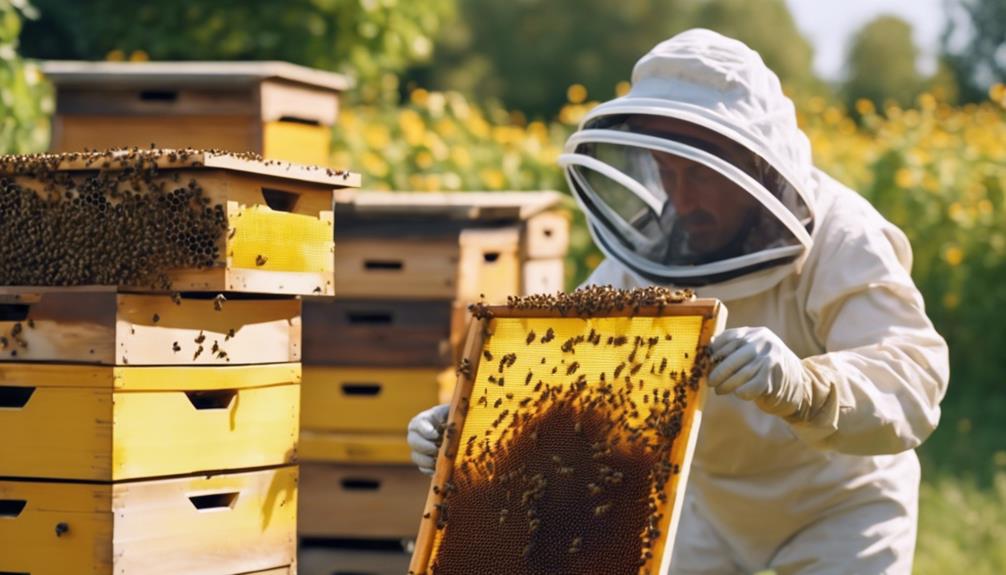
As we approach the hive, remember to do so quietly and slowly, respecting the bees’ space to keep them calm.
When working with the hive, move gently and avoid sudden motions that could startle the bees.
It’s essential to understand that patience and care are key in ensuring a smooth and safe hive inspection.
Quiet Approach Strategies
Approaching the hive quietly and gently is key to maintaining a peaceful environment and avoiding alarming the bees. To achieve this, remember these important tips:
- Minimize Noise: Keep your movements quiet to prevent startling the bees.
- Slow and Steady: Approach the hive with calm and deliberate actions to maintain a peaceful atmosphere.
- Be Gentle: Handle the hive with care and respect to avoid agitating the bees.
Slow Movement Tips
To maintain a calm hive environment and reduce bee agitation, employing slow and gentle movements is vital. When interacting with bees, our approach plays a significant role in their response. By moving slowly and deliberately, we communicate to the bees that we mean no harm. This gentle intrusion technique minimizes disruptions and fosters a peaceful environment within the hive.
Remember, bees are highly sensitive to sudden movements and loud noises, so keeping interactions serene is essential. Utilizing minimal equipment during hive inspections also helps in creating a harmonious interaction.
Patience and mindfulness are key; take your time, observe, and act with care. These simple practices can lead to a smoother and more productive experience with the bees.
Respect Bee Space
Moving slowly and gently around bees is essential to respecting their space and maintaining a calm hive environment. When interacting with bees, it’s vital to honour bee space to prevent triggering defensive responses.
Utilize minimal disturbance techniques to avoid unnecessary alarm among the bees. Developing handling skills is necessary for working within the hive without causing stress. By practicing gentle hive entry, we create a balanced environment that benefits both the bees and beekeepers.
Promoting Hive Harmony
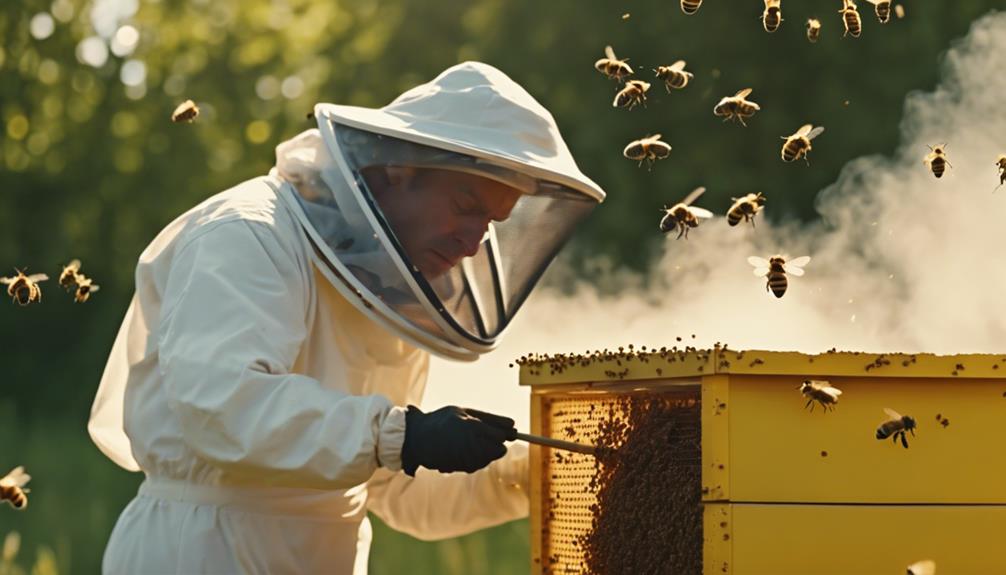
Let’s cultivate a peaceful hive environment by mastering gentle hive intrusion techniques and honing our manipulation skills to work harmoniously with bees without the need for smoke.
Understanding bee behavior and responses is key to minimizing disturbances and promoting hive harmony. By developing refined manipulation skills, we can interact with the bees in a way that respects their space and welfare.
Implementing strategies for hive management that prioritize calmness and respect for the bees leads to a harmonious environment without the use of smoke. Through these mindful beekeeping practices, we can create a space where bees feel comfortable and cared for, ultimately benefiting both the bees and our beekeeping endeavors.
Skills for Calm Bee Interactions
Approaching bees slowly and calmly is essential in minimizing defensive responses and fostering peaceful interactions within the hive. When engaging with these incredible creatures, remember these key points:
- Wear light-colored clothing and move smoothly to reduce bee agitation.
- Use a gentle touch when handling frames to minimize disturbance in the hive.
- Work during the warmer parts of the day when bees are more docile and less likely to be agitated.
Respectful Bee Manipulation
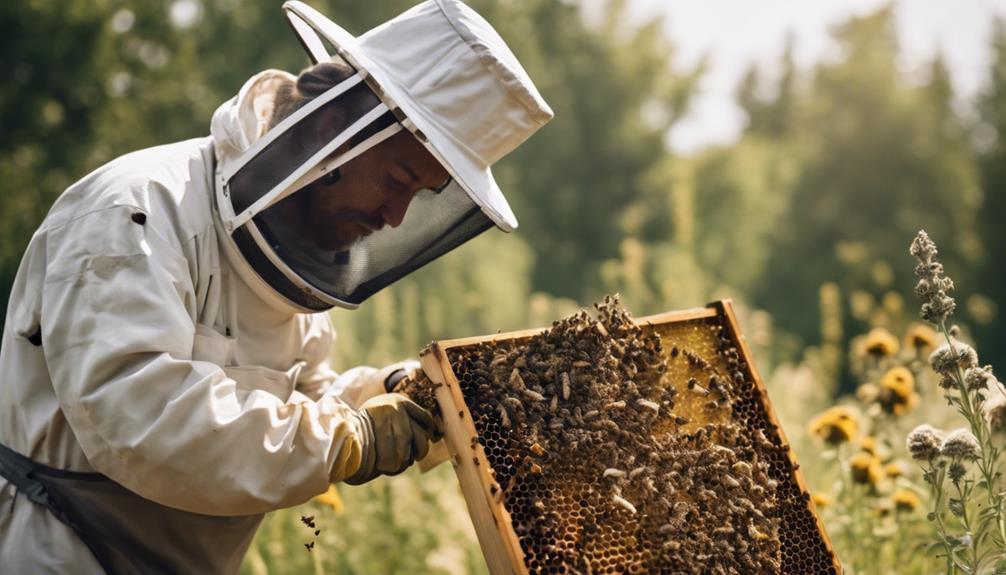
To handle bees respectfully, it’s crucial to minimize sudden movements and vibrations during interactions. Bees are sensitive creatures, and abrupt actions can agitate them. Working calmly and methodically around the hive is key to maintaining a peaceful environment for both the bees and the beekeeper.
When manipulating bees, using gentle and slow motions can help prevent triggering defensive responses. It’s also essential to utilize bee-friendly tools to interact respectfully with the colony. By practicing proper hive management techniques, you can reduce the need for smoke and create a harmonious relationship with your bees.
Harmonious Hive Environment
Creating a harmonious hive environment requires a deep understanding of bee behavior and a commitment to minimizing disruptions. To achieve this, beekeepers can employ the following techniques:
- Implement respectful hive intrusion methods to limit disturbances.
- Develop refined manipulation skills for gentle interactions with bees.
- Maintain a calm hive environment to promote colony health and productivity.
Smoke-Free Beekeeping Practices
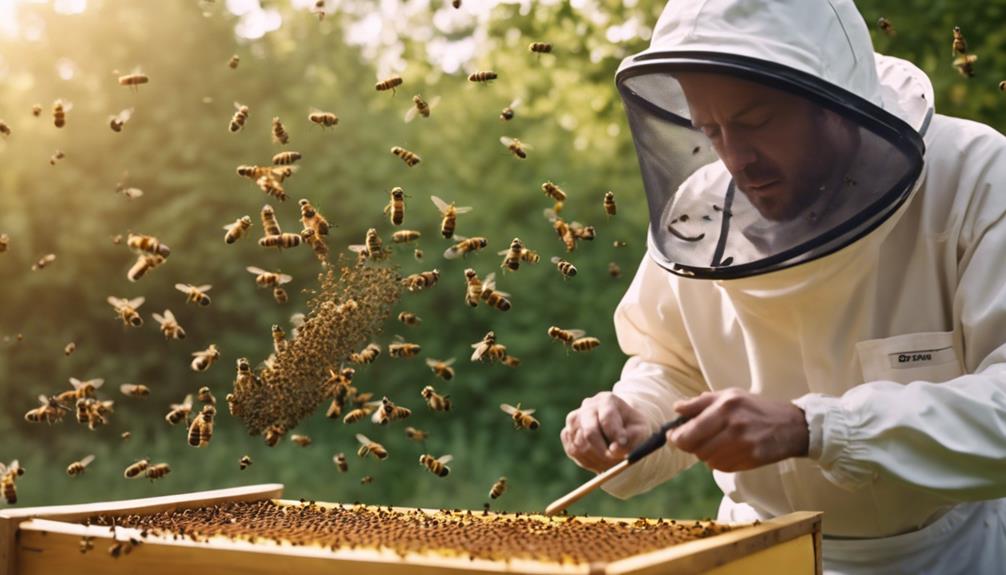
Exploring alternative methods to smoking bees can offer beekeepers effective and humane ways to manage their hives. When practicing smoke-free beekeeping, consider using water misting with essential oils like peppermint or sugar syrup sprays with Honey B Healthy for a calming and non-smoking approach.
Additionally, experiment with a mixture of liquid smoke and water as a milder alternative to traditional bee smokers. Remember to wear protective clothing and move slowly during hive inspections to reduce the need for smoke. By employing gentle handling techniques and minimizing disturbances, bees can settle down quickly without the use of smoke.
Embracing these smoke-free practices not only promotes a more natural and harmonious environment for the bees but also guarantees a more peaceful beekeeping experience for us.

Hello! My name is Noel Calvin. I graduated from UCLA and now work as a writer at Launch Ninjas. I write blog posts that inspire and guide our readers in their entrepreneurial pursuits. I live in Pleasantville, NJ, with a peaceful yet lively atmosphere that inspires me.
Writing stories is more than just a job for me. It allows me to share my observations and satisfy my curiosity about the world. I combine my analytical skills with creative enthusiasm to delve into technology trends and startup stories. But my life isn’t limited to screens and keyboards. I value loyalty, passion, and a touch of old-fashioned charm, which I infuse into every narrative I create.
I love spending time in my garage, jamming with my band when I’m not writing. Playing the guitar and singing bring me immense joy. I also enjoy capturing ordinary and extraordinary moments through my camera lens and exploring new culinary adventures that excite my taste buds. I’m always seeking new experiences.
My family is very important to me. Joyful Sunday brunches filled with laughter and intense board game nights keep me grounded, reminding me of life’s simple pleasures.
In my world, every moment is an opportunity for discovery. Every discovery is a story worth sharing, whether a heartfelt moment at home or the pulse of technological innovations. Join me as I navigate through life, one blog post, one guitar strum, and one heartwarming family dinner at a time.
